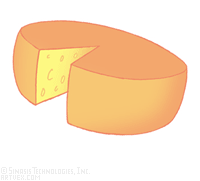
He prepared beef filets (sorry, Lynn) and topped them with a creamy sauce that featured Gorgonzola, meat drippings and mushrooms. I think that's all he used, but I may be wrong. I wasn't watching. I was way too busy visiting blog friends.
I should have taken a photo of the plate when it was served, but alas, I forgot.
We sometimes like to top our salads with this cheese, but a little goes a long way. As you can see, we have plenty left!
Now quoting from Wikipedia:
"Gorgonzola is a veined Italian blue cheese, made from unskimmed cow's milk. It can be buttery or firm, crumbly and quite salty, with a 'bite' from its blue veining."
There's much more, but I'll leave it there. I just look this stuff up so you don't have to bother.
